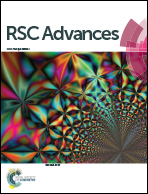Ion conduction behaviour in chemically crosslinked hybrid ionogels: effect of free-dangling oligoethyleneoxides†
Abstract
A series of PEO-functionalized, ladder-like structured polysilsesquioxane copolymers were synthesized and utilized for the fabrication of PEGylated hybrid ionogels through chemical crosslinking of the ionic liquid, 1 M LiTFSI in N-butyl-N-methylpyrrolidinium bis(trifluoromethylsulfonyl)imide. Through systematic variance of the copolymer concentration of methacryloxypropyl- and PEG groups, we were able to demonstrate enhanced ionic conductivity and lithium ion dissociation as the PEO content increased. Through an in-depth spectroscopic investigation of the ion conduction behavior of these PEGylated hybrid ionogels and comparison with hybrid ionogels without PEG groups, we were able to demonstrate how the enhancement in lithium ion battery performance for PEGylated hybrid iongels could be achieved at identical crosslinker concentrations.


 Please wait while we load your content...
Please wait while we load your content...